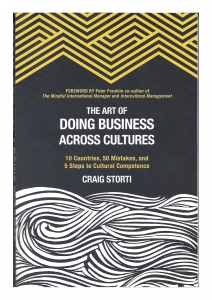The one sentence summary
There’s always a reason why people do the strange things they do, the reason is almost never to upset you, and there’s always a way forward.
WHAT THE BOOK SAYS 
- 50 common cultural mistakes made in business are presented as short conversations which show that there’s always a reason why people do the strange things they do. The reason is almost never to upset you, and there’s always a way forward.
- It covers American interaction with 10 countries: the Arab Middle East, Brazil, China, England, France, Germany, India, Japan, Mexico, and Russia.
- Anyone wanting to interact successfully with other cultures needs to consider 5 steps to cultural competence:
- Understand what culture is and how it affects business and workplace interactions.
- Identify the assumptions and values of your own culture.
- Identify the assumptions and values of the other culture.
- Identify the major differences between the two.
- React as appropriate (based on awareness and the experience offered).
- General dimensions of culture include:
Sense of identity (individualism v collectivism)
Locus of control/human agency (internal v external)
Sense of fairness (universalism v particularism)
View of human nature (benign v sceptical)
Sense of limits (unlimited v limited opportunity)
Sense of time (monochronic v polychronic)
Communication style (direct v indirect)
Concept of face (more v less important)
- Business/workplace dimensions are:
Performance orientation (task v relationship)
Management style (decentralised v centralised)
Attitude towards power (high v low power distance)
Concept of rank and status (egalitarian v hierarchical)
Attitude towards assertiveness (positive v critical)
Decision-making style (top down v consensus)
Attitude towards risk/uncertainty (risk tolerant v averse)
Degree of guidance and supervision (high v low)
Negotiating style (win/win v win/lose)
Worker-employer relationships (opportunistic v mutual loyalty)
Meeting style (problem solving v get together)
Short-term v long-term orientation
WHAT’S GOOD ABOUT IT
- You can look up a nationality and understand their approach better.
WHAT YOU HAVE TO WATCH
- Nothing. Read and learn.
